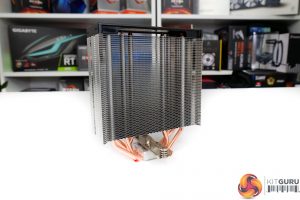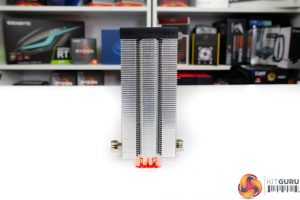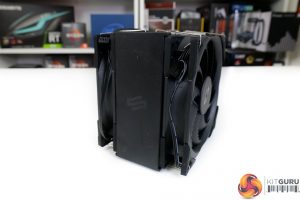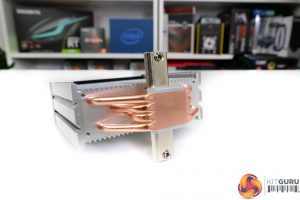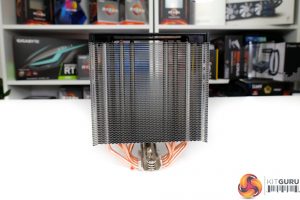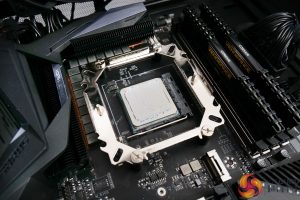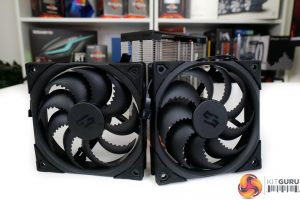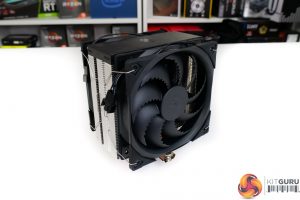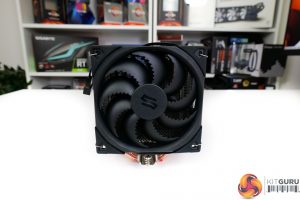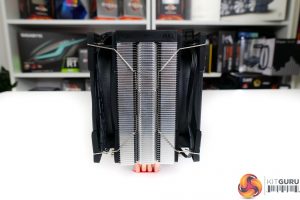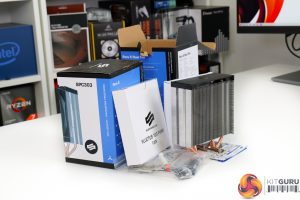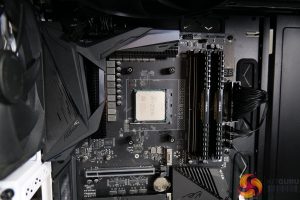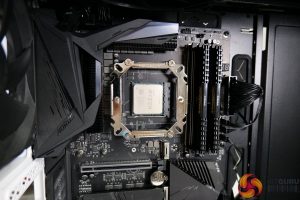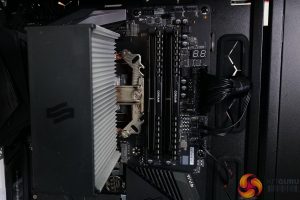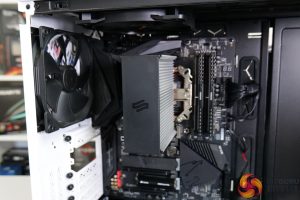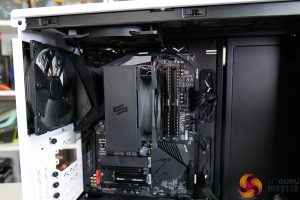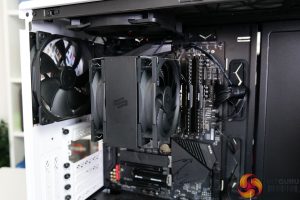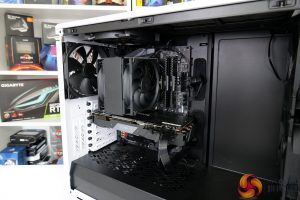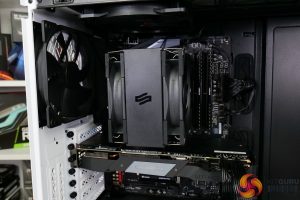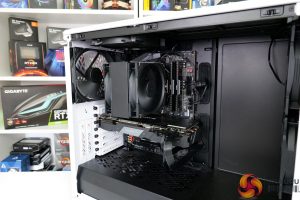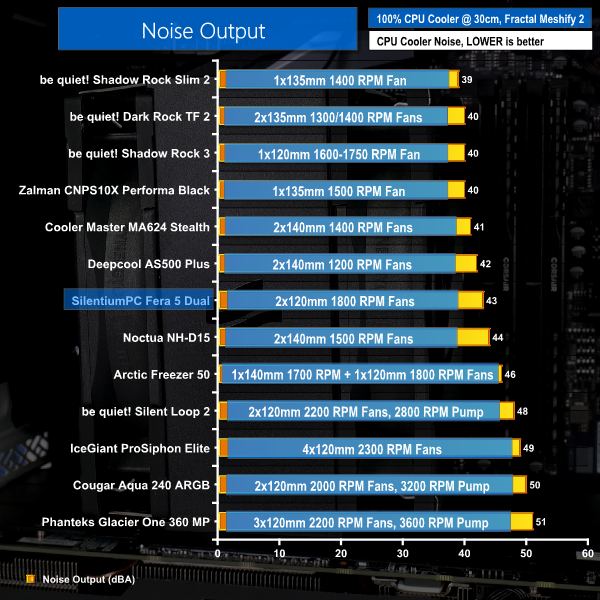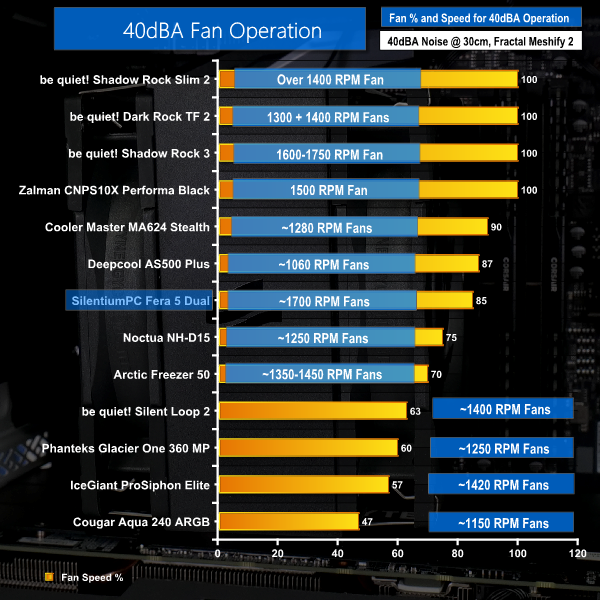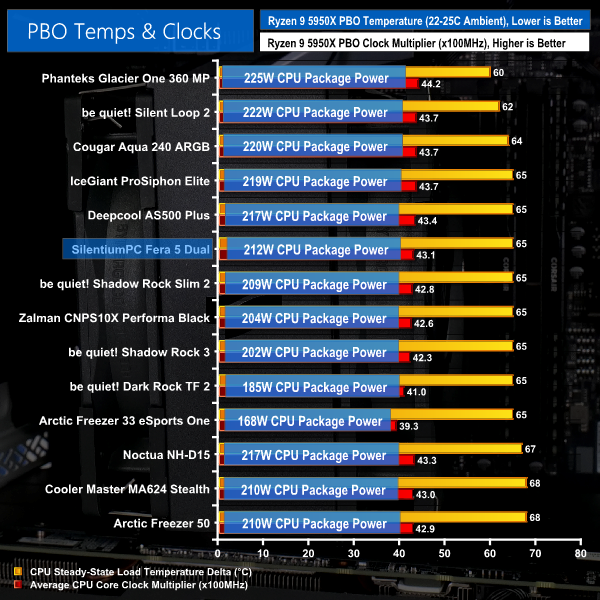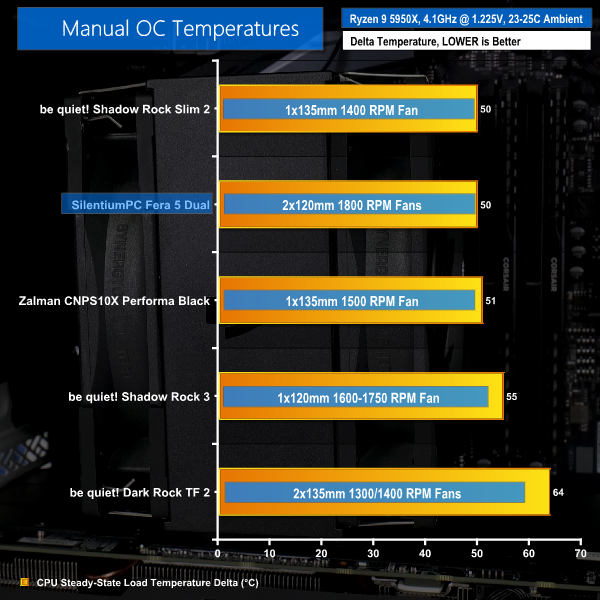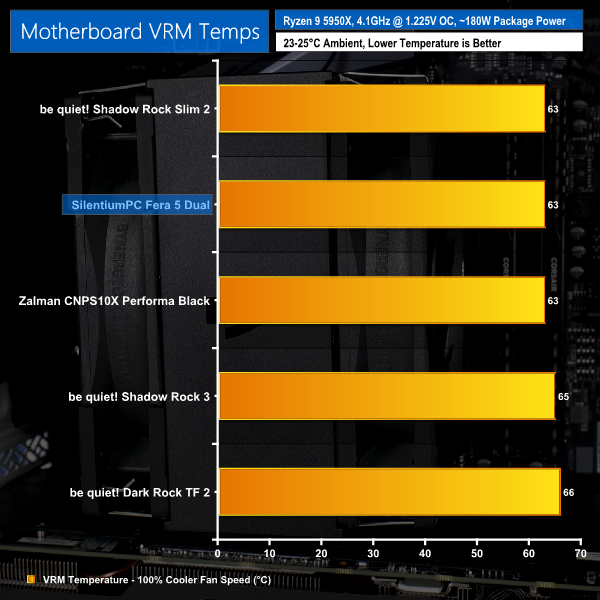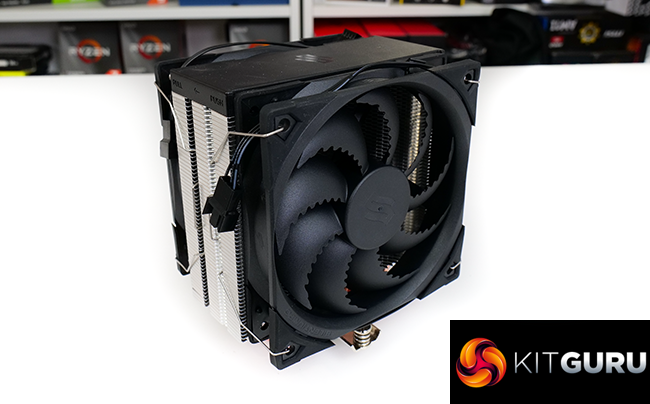
We are taking a look at a new 120mm-class CPU cooler that is very much intending to disrupt the budget end of the market – the SilentiumPC Fera 5 and the dual-fan version. Priced at a very competitive £24.99 for the single-fan version and just £5 more for the two-fan model, can these single-tower air coolers and their impressive 6-year warranty prove to be solid go-to options for budget buyers?
Video Timestamps:
00:00 Start
00:15 Introduction
01:09 Unboxing and first impressions
02:52 Heatsink layout and TDP
03:52 A closer look at the fans
06:23 Installation procedure
08:08 Test setup
09:41 Noise and 40dBa thermals
10:37 PBO and 4.1GHz fixed results
13:42 Luke’s final thoughts
Starting out with a look at the heatsink itself, SilentiumPC opts for a standard silver fin array that is representative of the aluminium material used.
The heatsink is asymmetrical by design and looks like it can be installed either way. However, SilentiumPC does mark 2 small arrows on the underside to indicate the intended airflow direction, as well as writing on the plastic top cover.
The fin array itself is 127mm wide, 110mm tall, and 52mm depth.
Adding in the plastic top cover increases the CPU cooler height notably. Installed on a processor, the Fera 5’s net height is around 155mm, so there should be no major chassis interference headaches
I personally like the top cover. It is perhaps unnecessary from an actual cooling perspective, but the dark black finish and SilentiumPC logo do look good. This is a far better appearance than the tops of the bare copper heatpipes underneath, in my opinion.
Running through the aluminium fin array are four 6mm diameter copper heatpipes. These emanate from the Heatpipe Direct Touch (HDT) base in a U-shaped orientation. SilentiumPC positions the coolers at different intervals throughout the fin array to aim to distribute the heat energy more evenly.
According to the manufacturer website, the quoted TDP of the cooler is 220W – whatever that means. Realistically, however, I would guesstimate that the very small base dimensions will be a tough challenge to overcome at higher heat loads.
There are no gaps between the flattened copper heatpipes, like we see on other HDT coolers. So, the base sizing doesn’t really cover an AM4 CPU heatspreader fully. But testing will show how much of an issue or non-issue this is.
SilentiumPC opts for 120mm fan units on the Fera 5, which is roughly what we would expect from a price point dominated by 120mm and 92mm coolers.
The Fluctus 120 PWM fan operates at a 300-1800 RPM speed range and is 4-pin PWM powered. Importantly, SilentiumPC highlights how the fan works in a semi-passive mode whereby the unit can actually stop spinning… motherboard fan function dependent of course.
Fan auto-stop is highlighted as below 5% PWM speed mode and start-up is at above 10% PWM point. Once again, this will heavily depend on your motherboard’s fan control implementation. Check out some of Leo’s recent videos for more on that topic.
The fans mount on rubber dampers to minimise noisy vibrations.
Utilising a fluid dynamic bearing design, the Fluctus 120 PWM fan has a rated MTBF of a highly impressive 100,000 hours. That’s particularly impressive and corresponds to an absolutely superb 6-year warranty.
72 months of warranty coverage from a sub-£30 CPU cooler is outstanding! Kudos to SilentiumPC there!
Specifications and Features (taken from manufacturer webpage):
- Developed with synergy cooling
- High performance, long life Fluctus 120 PWM fan
- Excellent acoustics
- Fan stop – optional semi-passive mode
- Asymmetrical heatsink
- Direct touch heatpipes
- Easy mounting system
- 6-year warranty
- Pactum PT-3 thermal compound
AM4 installation uses the default AMD backplate once the standard AM4 plastic fittings are removed.
Holding the backplate into position feels like a third hand is required, but once the SilentiumPC threaded standoffs are in place, the backplate remains secure.
The metal retention bracket then sits in position and is screwed in place at four points.
Then the CPU cooler heatsink can be bolted down using the two positions on its crossbar.
Finally, there is the straightforward process of attaching both fans with the supplied metal clips.
The overall process is very straightforward and not overly complicated; that’s especially true with the clear instructions.
The final mount is secure, and the black-framed fans and black-topped cooler create a very aesthetically pleasing visual appearance, especially if you’re not interested in RGB lighting.
There are several perfectly valid ways to test CPU coolers. We are primarily focussing on the performance of each cooler at 100% fan speed and also when locked to 40dBA noise output. We will focus on cooling performance using a manual overclock and Precision Boost Overdrive, as well as some reference to stock numbers. We will also highlight VRM temperatures.
Typically, we go for a 4.45GHz overclock, but this was too high for mid-range air coolers. As such, we backed off to a reasonable 4.1GHz fixed frequency and 1.225V BIOS voltage that generates around 180W of CPU package power to deal with. Given the introduction of this new 4.1GHz mid-range cooler test, we currently have limited comparison data. But check back for future review of additional mid-range coolers we have in for testing.
We decided to test using a chassis as we feel that this is most representative of real-world use cases. It does have some unwanted influences on the test data, as does open-air test bench testing. But we feel that this is a worthwhile trade-off for real-world chassis performance of the coolers.
Our chassis of choice is the Fractal Design Meshify 2 case that Leo reviewed and scored very highly. We like this chassis thanks to its high airflow optimisation and well-vented front and top panels.
The fan configuration is the three included Fractal Dynamic X2 GP-14 fans spinning at full 1000 RPM speed. In addition to the two 140mm front-mounted fans, and single 140mm rear exhaust, we added a be quiet! Pure Wings 2 1000 RPM 140mm fan as roof exhaust for air cooler testing. The aim here was to keep consistency with the airflow path of the liquid coolers which are always roof mounted.
If you want more details on our CPU cooling test procedures, check out some of our previous articles HERE, HERE and HERE.
CPU Cooling Test System:
- Processor: AMD Ryzen 9 5950X
- Overclocked Settings: 4.1GHz all-core @ 1.225V (UEFI), Medium LLC – around 180W-190W delivered
- Motherboard: Gigabyte B550 Aorus Master
- Memory: 32GB (2x16GB) Corsair Vengeance LPX 3600MHz 16-18-18-36 DDR4 @ 1.35V
- Graphics Card: Gigabyte RTX 2060 Super 0dB Mode
- Chassis: Fractal Design Meshify 2
- Chassis Fans: 2x140mm 1000 RPM Fractal Front Intake, 1x140mm 1000 RPM Fractal Rear Exhaust, 1x140mm 1000 RPM be quiet! Pure Wings 2 Roof Exhaust (for air cooler testing)
- Power Supply: Seasonic Prime TX-1000
- OS SSD: Corsair MP600 NVMe M.2 SSD
- Operating System: Windows 10 Pro 64-bit
Comparison Coolers:
- SilentiumPC Fera 5 Dual – £29.99, 2x120mm 1800 RPM Fans
- be quiet! Dark Rock TF 2 – £79.99, 1x135mm 1400 RPM Fan + 1x135mm 1300 RPM Fan
- be quiet! Shadow Rock Slim 2 – £43.99, 1x135mm 1400 RPM Fan
- Zalman CNPS10X Performa Black – around £38, 1x135mm 1500 RPM Fan
- Arctic Freezer 33 eSports One – £29.99, 1x120mm 1800 RPM Fan
- be quiet! Shadow Rock 3 – £44.99, 1x120mm 1600 RPM Fan (operated up to 1750 RPM according to our motherboard sensor)
- be quiet! Silent Loop 2 – £199.99, 2x120mm 2200 RPM Fans, 2800 RPM Pump
- Deepcool AS500 Plus – £64.99, 2x140mm 1200 RPM Fans
- Noctua NH-D15 – £80, 2x140mm 1500 RPM Fans
- Cooler Master MA624 Stealth – £99.99 MSRP, 2x140mm 1400 RPM Fans
- Arctic Freezer 50 – £59.99, 1x140mm 1700 RPM + 1x120mm 1800 RPM Fans
- Cougar Aqua 240 ARGB – £89.99-£99.99 MSRP, 2x120mm 2000 RPM Fans, 3200 RPM Pump
- Silverstone IceGem 240P – £119.99, 2x120mm 2200 RPM Fans, 3000 RPM Pump
- Phanteks Glacier One 360 MP – £154.99, 3x120mm 2200 RPM Fans, 3600 RPM Pump
- G.SKILL Enki 360 AIO – $179.99 MSRP, 3x120mm 2100 RPM Fans, 5000 RPM Pump
- IceGiant ProSiphon Elite – £169.99, 4x120mm 2300 RPM Fans
Testing Methodology:
- For testing, we use a 30-minute looped run of Cinebench R23 and record the steady-state CPU temperature at the end of the test. This ensures that the CPU has had ample time to warm up and reach steady state under all of the coolers.
- Ambient is maintained around 23-25 degrees Celsius. Where there is variation beyond this temperature range, we add in extra repeated tests to ensure consistency.
- We also test each cooler with at least two fresh installs (typically three) to mitigate the likelihood of a dodgy mount spoiling results.
Let’s start off with noise performance from each cooler at 100% fan speed.
This is important as it sets the precedence for which coolers we expect to deliver the higher levels of performance based on the faster and louder fans. Assuming that their performance is efficient in comparison to their noise output levels, that is.
The chassis fans are disabled, all case panels are on, and the sound meter is placed 12 inches from the side of the Fractal chassis’ glass side panel – roughly where a desk user will be sat.
Coming in at 43dBA with its pair of 120mm fans at full speed, the Fera 5 Dual is reasonable in terms of noise performance, but not outstanding.
The cooler is undeniably audible with the fans pushing at 1800 RPM, but I would not call the noise level intrusive by any stretch.
Of course, there is that excellent PWM speed control range of the Fluctus 120 PWM fans that allow for strong noise tuning.
Dropping the fans to 85% speed – which actually registered as 1700 RPM through our motherboard header – got us to 40dBA noise output.
This puts the Fera 5 Dual about mid-table in terms of how close it can get to full fan speed whilst hitting 40dBA.
Let’s start by looking at Precision Boost Overdrive test results. With 90C the maximum target temperature for PBO, we are looking at how the cooler achieves the balance between lower temperature operation and higher PBO clock speeds. Higher clocks with lower temperatures are better. But one cooler may run at slightly higher temperatures than another, albeit with higher clock speeds, so look out for that.
In essence, this test is showing us how far the cooler can be pushed while keeping a sensible 90C maximum. Or whether there is more room for pushing clocks and power delivery beyond the PBO limits while still sticking to a 90C target.
Firstly, it is critical to note that small difference in the displayed delta temperatures are not important for our PBO testing as the clock speed and cooling power achieved are more important metrics.
A very strong start is made by the dual fan Fera 5 in our PBO test. Managing to cool 212W of package power is excellent and actually beats out the more expensive be quiet! Shadow Rock Slim 2 as a mid-range reference point.
Impressively, this saw our 5950X test CPU running at 4.31GHz all-core which was at least a couple of hundred MHz higher than what we saw from other mid-range level coolers.
This is a very good start by SilentiumPC.
If you are interested in stock results, the Fera 5 Dual runs at 32-33C above ambient which is – once again – about the same as the be quiet! Shadow Rock Slim 2.
The 5950X quoted all-core frequency here was around 3.85-3.86GHz which is marginally higher than the Zalman and be quiet! 135mm models, albeit by an insignificant difference.
Moving on to our new 4.1GHz fixed frequency overclocked test, as we have only recently added the new 4.1GHz mid-range cooler test to our suite, we have very limited comparison data at the moment. Do check back on future reviews, as we have quite a few mid-range CPU coolers for test over the coming weeks, so the charts will start to show significantly more comparison data.
As we are locking the voltage and clock speed, the temperature figures are directly comparable between competing coolers. We see package powers in the order of 180-190W for the CPU and wall power levels that exceed 260W for the system.
Note the use of delta temperature data in our charts and factor in your own ambient conditions for reference.
The same impressive cooling performance continues through to our manual OC testing. Here, the dual-120mm Fera 5 is tied for top position with the be quiet! Shadow Rock Slim 2. While the be quiet! cooler is more expensive, the SilentiumPC cooler is louder and does lose around 1C of cooling performance when restricted to 40dBA.
Nevertheless, this is another strong thermal performance from the SilentiumPC Fera 5 Dual.
We highlight VRM temperatures when using each cooler on our Gigabyte B550 Aorus Master motherboard with the overclocked Ryzen 9 5950X. Do note that the results are heavily influenced by the specific layout of the Gigabyte B550 Aorus Master test motherboard with respect to top-side or rear IO-side VRM components. Your findings may vary if you have a different motherboard VRM layout and heatsink design.
VRM cooling proficiency was also positive. This is an interesting one, as the larger dimension fans of the competing 135mm coolers should provide greater incidental airflow to the motherboard VRM heatsink. But the SilentiumPC Fera 5 Dual still managed to match the VRM cooling performance shown.
Perhaps that extra 120mm fan helps just as much as the oversized 135mm diameter alternative.
Overall, we are very impressed by the performance on offer by the SilentiumPC Fera 5 Dual. This £30 CPU cooler punches well above its weight in terms of AM4 cooling performance. And it does so whilst feeling like a quality item that we would associate with a price tag at least £10 higher than what the unit actually sells for.
Batting in the same cooling territory as the physically larger and more expensive 135mm coolers that we have tested recently is impressive from the Fera 5 Dual.
As far as downsides go, the only notable gripe we have is that noise output from the 120mm PWM fans at full speed is pretty loud. The units are not too bad, but they’re certainly noticeable when pushing at full pelt.
Thankfully, though, the Fluctus 120 PWM fans have an excellent speed control range with semi-passive operation. So, it is perhaps a little harsh to call noise output a major downside.
At less than £30 and with the cooling performance and quality workmanship on offer, I am pretty blown away by the SilentiumPC Fera 5 Dual. You get great thermals, excellent fan speed control, a superb warranty, easy installation, and stellar aesthetics.
This really is an impressive product, and I would have no hesitations in making a strong recommendation.
The SilentiumPC Fera 5 Dual is available for £29.99 at Scan.
Discuss on our Facebook page HERE.
Pros:
- Strong thermal performance
- Excellent fan speed control
- A superb 6-year warranty
- Easy installation
- Stellar aesthetics
- Outstanding value
Cons:
- Full fan speed noise is noticeable
KitGuru says: Strong thermal performance, wide fan speed control, and backed up by a 6-year warranty, the value on offer in the SilentiumPC Fera 5 Dual is simply remarkable.
Be sure to check out our sponsors store EKWB here
 KitGuru KitGuru.net – Tech News | Hardware News | Hardware Reviews | IOS | Mobile | Gaming | Graphics Cards
KitGuru KitGuru.net – Tech News | Hardware News | Hardware Reviews | IOS | Mobile | Gaming | Graphics Cards


